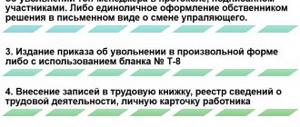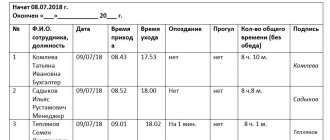How an archive of personal files of dismissed workers is compiled
After the dismissal of employees at the enterprise, the HR department must know how to properly and for how long documents should be saved. They organize the process of storing personal files of workers who left the organization, not by their last name, first name, patronymic, but in order according to the dates of the orders. Next, they are carefully stitched together for the year by number, an inventory is attached and transferred to the archive of the personal files of dismissed employees, distributed by year.
The need for an archive
Cases for transferring documents to the archive are formed by name in different folders. This needs to be done correctly. In one folder you can store data for vacations, and in the second there should be documents for dismissals.
Separately, the personnel service employee lays down the grounds for transfers and awards.
But documents need to be folded and stapled to form an archive of dismissed employees in a sequential order. Must be stored for at least 75 years . During the archiving process, documents are divided taking into account standard storage periods. After the end of each year, it is necessary to staple all orders and archive the personal cards of employees dismissed from the enterprise.
The documents are then sealed and presented to the archivist. If you don't have a file cabinet, you can lock the folders in a fireproof cabinet. Documents of dismissed employees should be kept separately from those of active employees.
Legal entities, ordinary citizens and government officials are required to ensure the integrity of information about previously employed employees for a certain period. Representatives of companies and citizens have the right to request information to gain access to the archive of personal files of laid-off workers.
Personnel department employees issue certificates and copies of documents free of charge for presentation to the pension fund and social security authorities for receiving benefits.
The available data is also used as evidence. Then the previously seized documents are given to the owner.
Formation of a personal file
The procedure for collecting information about employees is strictly regulated. The documentation should include:
- Application form and resume.
- Personal sheet of the HR department.
- Characteristics of the employee.
- TIN, insurance certificate.
- Employment contract.
- Orders on transfers, vacations and business trips.
You need to know how to store the personal files of dismissed employees. Thus, an employee’s personal card, created on the basis of a dossier, is left in the company’s personnel policy until the end of the working year. Within three years after leaving the organization, documents undergo archival and technical processing. After this, they are transferred to the archives of the institution.
You can store documents in the archive if you have an annual inventory. The HR department collects a list of employees who left the company over a certain period of time. The date of dismissal is indicated on the cover of each case.
Storage systematization
According to the instructions, only original documents can be submitted to the archives. Photocopies may be left as attachments to orders for admission, dismissal or relocation. Personal cards of workers should be stored according to the following rules:
- Cards for former employees are kept on paper.
- They are put into folders with further numbering and firmware.
- On the cover of any created folder there are numbers and the number of cases in it.
- The HR department can store cards of currently employed employees.
- The personnel officer hands over all personal cards of employees dismissed from the organization to the archive and stores them by date, and within the dates they distribute them alphabetically.
Storage is organized in special cabinets to protect from fire and moisture.
The law establishes the time for which documents must be preserved. The main rules were approved back in February 2002 by the Board of Rosarkhiv.
The rules for creating an archival fund do not apply to papers with a storage period of less than ten years. Personal files of dismissed citizens are stored as follows:
- Employment contracts, cards and personal files are saved for 75 years.
- Data on admission and relocation - 5 years.
- Questionnaires - at least 12 months.
- Extracts from reports - 75 years.
- The lists of employees are also 75 years old.
- Informative data on tariffs and salaries - 10 years.
- Acts of accounting of labor books - 36 months.
- Substitution applications are valid for 3 years.
The files of dismissed workers are transferred to the archives. They are processed after the end of the year. Depending on the storage time and value of documents, cases can be processed in full or according to a simplified scheme. Documents of managers, managers and persons with degrees and awards are stored indefinitely, while personal cards of dismissed employees who do not hold management positions are stored for 75 years .
Source: https://trud.help/docs/arhiv-lichnyih-del/
Storage of official papers
Established norms in Art. 3 of Federal Law No. 152-FZ of July 27, 2006 determine that the employer is obliged to protect personal data and is responsible for their disclosure. Responsible persons may be subject to material and disciplinary liability, and in some cases, administrative or criminal liability. That is why the head of the enterprise must appoint by order the person responsible for the management of affairs and their registration. When gaining access to personal information, it cannot be disclosed without official consent.
Personal information must be protected from prying eyes, damage or theft. For this purpose, a safe or metal cabinets with a lock are often installed; folders are distributed in any order, including alphabetical order. Employees have the right:
- Process all data and study it in detail.
- To gain access to all information. If necessary, an employee may request a copy of any document, with the exception of cases from clause 8 of Art. 14 Federal Law dated July 27, 2006 No. 152-FZ.
- To protect information, appoint official representatives.
- Get free access to medical documents that were included in the case.
- Require that all persons be notified of important information that has been changed.
- Request that personal information be deleted or changed if it was entered incorrectly. If a refusal was received, a sheet may be filed in the folder in which the employee indicates disagreement with certain information. This statement is also included in the case file.
- Appeal in court the employer’s decision to disclose the employee’s personal information to third parties. In this case, you can demand compensation for the damage caused.
At the request of the employee and his written permission, information may be provided to third parties. Documents must be provided by law enforcement and certain other authorities when filing a formal request.
List of documents for the formation of a personal file when submitting to the archive
— Constitutional law — List of documents for the formation of a personal file when submitting to the archive
Personal things. In personal files, all documents are located only in the chronological order of their receipt. For all documents contained in the personal file, an internal inventory must be drawn up, which contains the following details:
- serial number of the document included in the inventory;
- document number and date (if necessary);
- Title of the document;
- number of sheets in the document;
- note;
- final record of the number of documents in the personal file.
The approximate order of arrangement of documents in a personal file is as follows: internal inventory of case documents, personnel records sheet or questionnaire, job application, autobiography, certified copies of personal documents, certified copies of orders for admission, appointment, relocation, job responsibilities, certification documents etc.
Preparing HR files for transfer to the organization’s archives
Inventory of files submitted to the archive After receiving cases, when submitting documents to the archive, the head of the archive signs on three copies of the inventory of permanent storage cases and on two copies of the Acceptance Certificate for the delivery of documents to the archive. The second copies are returned to the sender, the rest remain in the archive.
The end of submitting documents to the archive ends with filling out accounting documents. Documents are transferred to state archives after the expiration of storage periods, but there are cases of early transfer of documents. An example of early delivery of an archive could be the delivery of an archive for free storage during liquidation (bankruptcy) and vice versa, materials can be left for an additional period.
Documents archive
Important This event is also carried out in cases of reorganization, when documentation is transferred to the legal successor (the period for transferring cases in both cases is two months). It is also necessary to transfer files to departmental storage at intervals of approximately once every 3 years.
Rules for submitting personal files to the archive
When preparing cases for submission to the archive or for subsequent storage in the personnel service, an examination of the value of the cases is carried out using the method of sheet-by-sheet review of the cases. It is not allowed to examine the value of cases by looking only at their titles.
When conducting an examination of the value of files in the personnel service, special attention must be paid to files with permanent and long-term (over 10 years) storage periods, since these are the files that are subject to transfer to the organization’s archive. Personnel service files with a temporary (up to 10 years inclusive) storage period are not transferred to the archive, they are stored in the personnel service and, upon expiration of the storage period, are subject to destruction according to established rules.
Registration of cases in the personnel service Registration of cases is carried out by employees of the personnel service with the methodological assistance of the organization’s archive. The HR service is obliged to submit files to the archives fully completed.
Personal file: current storage and transfer to the archive
Formation of cases And it should be carried out right up to the dismissal of the employee.
It is then transferred to the archive for storage. This document cannot be destroyed for a certain period of time.
Required or optional? It has already been said that it is not at all necessary to lead employees. But any self-respecting enterprise has this kind of documentation. When is it necessary to create a dossier and when is it not? Rules on this issue are not prescribed by law anywhere.
Maintaining an employee’s personal file A personal file consists of the cover of the personal file and the employee’s documents, which contain comprehensive information about the employee and his work activity (if we are talking about a student, then information about his training).
managers and their deputies; leading specialists; financially responsible employees (cashiers, storekeepers, etc.); employees with the prospect of promotion, etc.
State Archives: how to submit an employee’s personal file
When preparing files for filing (binding), metal fasteners (pins, paper clips) are removed from the documents. 3.6.5.
Transferring personal files to the archive
Selected questions encountered when preparing to transfer personal files to the archive
Legal regulation
In this article we will talk about how to overcome mistakes that arise when creating personal files for employees. Just in case, let's say a few words about what constitutes a personal matter.
Personal file - a selection of documents about an employee
The personal file begins with the documents that are drawn up upon admission to work (personal personnel record sheet, autobiography, application for employment, a copy of the hiring order), continues and ends with copies of orders for transfers, part-time work, awards, dismissal of an employee, etc. .
Personal affairs are mentioned in Art. 337 of the Standard List of Management Documents generated in the activities of organizations, indicating storage periods, approved by the Federal Archive on October 6, 2000 (hereinafter referred to as the Standard List).
At the same time, it should be noted that personal affairs are mainly conducted in the records management of those personnel services that are government bodies and whose employees, in accordance with current legislation, are classified as civil servants. In other organizations, personal affairs are conducted at the discretion of personnel services.
Due to the fact that current legislation requires maintaining only personal files of civil servants, many commercial organizations currently simply refuse to maintain personal files, leaving only personal cards for personnel records management.
Standard list of documents
According to the Standard List, personal files of the organization’s leaders, members of the organization’s governing, executive, and control bodies; employees with state and other titles, prizes, awards, academic degrees and titles are kept permanently, for other employees - 75 years. Based on paragraphs. 3.6.3 of the Basic Rules for the Operation of Archives of Organizations, personal files of employees need to be fully documented.
Full registration of cases includes:
- file filing or binding;
- numbering of case sheets;
- drawing up a certification sheet;
- drawing up, if necessary, an internal inventory of documents;
- introducing the necessary clarifications into the details of the cover of the case (clarification of the name of the organization, the registration index of the case, the deadlines of the case, the title of the case).
The rules also describe other requirements for the formation of personal files.
In addition, by Decree of the President of the Russian Federation dated 06/01/1998 N 640, from the total volume of personal files compiled by personnel services of organizations, personal files of persons holding public positions of the Russian Federation in the order of appointment and public positions of the federal civil service are allocated into a separate group (the Decree does not apply regarding the procedure for maintaining personal affairs of state civil servants of the Russian Federation).
In addition, there are regulations of the relevant departments that should guide subordinate organizations, for example, Requirements for organizing office work in non-state pension funds, approved by Order of the Inspectorate of Non-State Pension Funds under the Ministry of Labor of Russia dated August 31, 2001 N 115.
Problems and solutions
However, when creating personal files, problems often arise, specific solutions to which are not provided for by current legislation. Working with personnel archives, the author of this article has encountered such complex issues more than once. In this article I tried to give possible answers to the two most interesting of them.
https://www.youtube.com/watch?v=KxWkRFiRTv0
Question 1: When preparing personal files for archival storage, they often contain documents that do not have dates. This mainly occurs due to the fault of the personnel service employees themselves, who forget to indicate the dates of documents or accept documents without dates from employees. How to generate documents that do not have dates?
Answer: Before answering this question, it is necessary to check whether the documents we are considering are indicated in the inventory of documents in the personal file.
Let us recall that in the internal inventory of documents of a personal file, data on the documents that make it up is entered in the form of a table indicating in its columns the serial number of the document, the name of the document, the date of the document and other necessary information.
Such an inventory is usually compiled by employees of the personnel department, which maintains a specific personal file.
Undated documents should be generated after it
But only on the condition that these documents really should be stored in this personal file, which is established by the relevant regulatory documents - Model or departmental lists, Decree No. 640, etc.
If you can establish that documents included in the second group should not be stored in a personal file, it is necessary to seize such documents and carry out further work with them in accordance with established requirements (form them into separate files or with other files, transfer them according to the delivery list to the archive, or set aside for destruction according to the act, etc.).
Question 2: In the employee’s personal file, the employment order is dated earlier than his application. In what order should the specified documents be formed in the personal file?
Answer: Personal records are usually arranged in chronological order.
However, according to the logic of the events reflected in these documents, the employee first had to write an application for employment, and only then an order should have been issued.
In this case, to systematize documents, a logical sequence should be observed. Based on the meaning of the Basic Rules, the peculiarities of the formation of cases in such non-standard situations should be reflected in the appropriate preface.
The preface could read like this:
Example 1. Individual documents of personal files that do not have dates, but were previously included in the inventory of documents available in the personal file, are formed at the end of each file before the inventory, not recorded - after the inventory. In a number of personal files, employee bypass sheets that were previously included in the inventory of documents available in the personal file were left.
Example 2. In the employee’s personal file, the employment order is dated earlier than the application. This order was not preserved in the process of systematizing the documents of this personal file.
The documents are presented in a logical sequence, that is, in the order that must be followed when applying for a job.
From the situations considered, it is clear how difficult the process of preparing personal files for archival storage is due to their non-compliance with current regulatory documents.
Source: https://mosarchiv.ru/stat/peredacha-v-arkhiv-lichnykh-del-/
Who has access to personal data
Permission to access these documents is regulated by order of the head of the organization. The employee of the organization himself has the right to any information from his file.
The duty of the personnel officer is to familiarize him with the personal file of a civil servant at least once a year; no such requirement has been established for commercial organizations. The fact of familiarization with the contents is recorded with a personal signature and the date of familiarization in the card attached to the civil servant’s case.
Violators of legislation in the field of personal data may be subject to disciplinary (subclause “c”, clause 6, part 1, article 81 and article 192 of the Labor Code of the Russian Federation) and material (clause 7, part 1, article 243 of the Labor Code of the Russian Federation) liability, as well as civil, administrative (Articles 13.11 and 13.14 of the Administrative Code of the Russian Federation) and criminal (Articles 137 and 140 of the Criminal Code of the Russian Federation).
It is important to remember that working with personal data without the written consent of the employee, if these actions do not contain criminal offenses, entails a fine (Part 2 of Article 13.11 of the Code of Administrative Offenses of the Russian Federation):
- for citizens - from 3,000 to 5,000 rubles;
- officials - from 10,000 to 20,000 rubles;
- legal entities - from 15,000 to 75,000 rubles.
It is important to remember that for the disclosure of personal data, liability is provided in the form of dismissal for those responsible (see subparagraph “c” of paragraph 6 of Article 81 of the Labor Code of the Russian Federation).
What documents from the employee’s personal file are archived?
Ministry of Culture of Russia dated August 25, 2010 No. 558). Read more about dismissal here: Thus, orders for hiring, transfer, dismissal and other orders for personnel must be kept for at least 75 years. An exception to this rule is orders for granting vacations, sending on business trips in Russia (as well as other documents about business trips: assignments, reports, etc.), as well as orders for penalties.
They only need to be stored for five years. Employment contracts, personal cards and personal files of employees must also be kept for 75 years, and personal files of managers - permanently. The staffing table is also required to be maintained at all times. Workplace certification materials should be stored for 45 years, and in difficult, harmful or dangerous working conditions - 75 years. Keep the labor regulations even after replacing them with new ones. Shelf life is one year.
Is it possible to fill out T-2 card sheets on a computer and print them out?
Let's consider your questions:
- Hello, the T-2 card has run out of space in the “Vacation” section, tell me, is it possible to attach an additional sheet of this section, or do I need to fill out a new T-2 card, but only with the last vacation period?
Instructions approved by the resolution of the State Statistics Committee of Russia dated January 5, 2004.
No. 1, do not contain explanations about filling out a personal card if any of its sections is completely filled out. However, in practice, employers act as follows.
After the “Vacation” section is completely filled out, an addition is made to the employee’s personal card. To do this, on a blank sheet of paper of the appropriate format, make an entry “Addendum to the employee’s personal card” (Form No. T-2), indicate the date of completion and enter the employee’s data (last name, first name, patronymic, date of birth, position and structural unit, as well as details employment contract). Then indicate the number and title of the relevant section (for example, VIII.
VACATION) and transfer its tabular part.
Such additional sheets can be issued for any completed section of the personal card.
The number of additions is unlimited, so you can maintain a unified form for many years.
- Can I fill out T-2 card sheets on a computer and print them out?
The legislation does not contain specific requirements for filling out a personal card form T-2. Therefore, it can be filled out both in handwritten and printed form.
How to submit an employee’s personal file to the state archives
To take into account the number of sheets in the case and record the peculiarities of their numbering, a document certifying sheet is drawn up (see Appendix 2). The document certifying the case is signed by its compiler, indicating the transcript of the signature, position and date of compilation. All subsequent changes in the composition and state of the case (damage, replacement of original documents with copies, addition of new documents, etc.
) are noted in the document certifying the case with reference to the relevant act. To record documents of certain categories of cases with permanent and long-term (over 10 years) storage periods, an internal inventory of case documents is compiled. The internal inventory is compiled on a separate sheet according to the established form (see Appendix 3).
A final record is drawn up for the internal inventory of the case, which indicates in numbers and in words the number of documents included in it and the number of sheets of the internal inventory.
Archiving personal files of dismissed employees
Important During your working life, your personal file is supplemented with other documents. The last, final document in the personal file folder will be a copy of the order to terminate the employment contract. This procedure follows from clauses 3.5.3 and 3.6.18 of the Rules, approved by the decision of the Rosarkhiv board of February 6, 2002.
Documents are located in the personal file in chronological order as they are received (clause 3.5.5 of the Rules, approved by the decision of the Rosarkhiv board of February 6, 2002). Storing personal files In the HR department, keep the personal files of working employees only.
Before filing (binding), remove staples from all documents.
Submission of documents for storage to state archives
Depending on the volume, composition of documents, their storage periods, the format of personnel files, as well as for the purpose of quickly searching for the necessary information to confirm seniority and wages, separate inventories of personnel files can be compiled:
- orders;
- personal files of those dismissed;
- personal cards of dismissed people;
- personal accounts for wages;
- payroll statements;
- unclaimed personal documents (work books, certificates, etc.);
- acts of industrial accidents, etc.
Rules
- Organizations and individuals undertake to retain data about former employees during the above periods.
- Citizens and representatives of enterprises have the right to submit requests to obtain information from the archives.
- Copies and certificates of documents regarding social and pension issues, benefits and compensation are issued free of charge.
- Archival data can be transmitted in the form of electronic documents.
First of all, the ability of the latter to confirm the corresponding marks in their work books depends on how long the personal files of dismissed employees are kept. If suddenly a former employee makes a request, and the company has already finally gotten rid of the documents on it, there is a violation by the employer of the legislation on archival matters.
For failure to comply with the deadlines discussed at the beginning of the article, the personnel officer may be fined up to 500 rubles (Article 13.20 of the Code of Administrative Offenses of the Russian Federation).
Also see “How long should you keep accounting documents.”
If you find an error, please highlight a piece of text and press Ctrl Enter.











